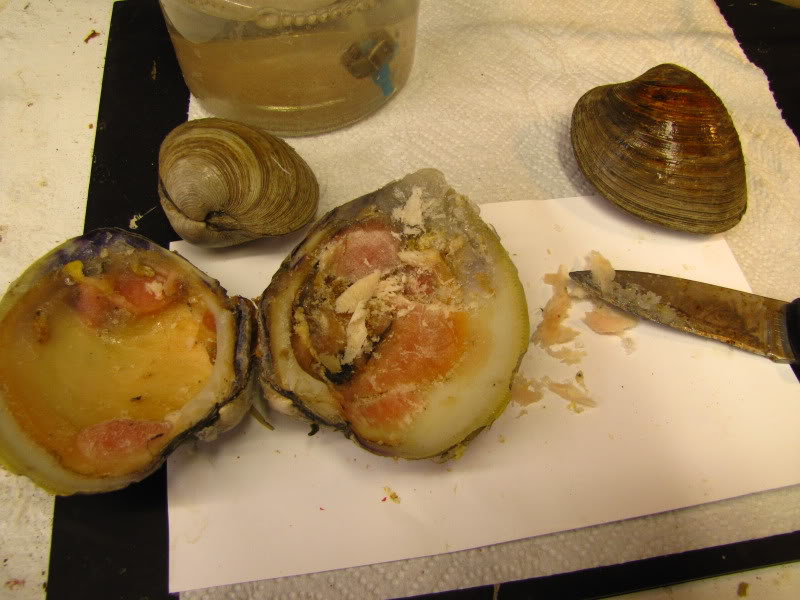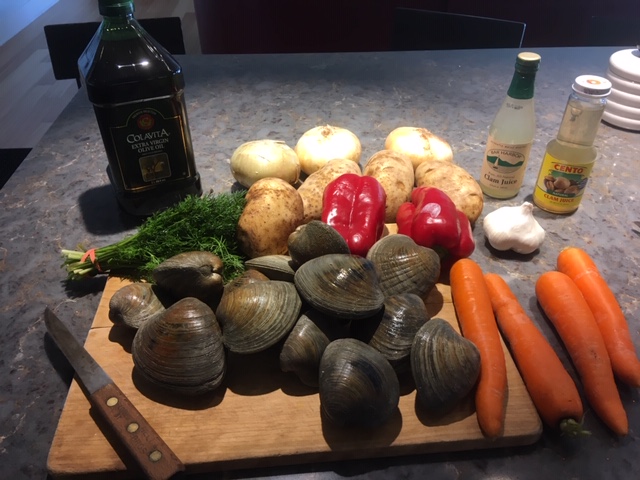Clams, the absolute best food for salt water fish
The title says it all. If I could only feed one type of food, it would be regular, common, cheap, (near the coasts of the US) available, clams.
I myself feed clams almost every day to all my fish and have been since the 60s. Virtually all the fish eat it, that includes mandarins, pipefish, queen anthius, moorish Idols etc. All invertabrates also eat it such as crabs, urchins, shrimp, anemones and coral.
Not only do they eat it, but it is probably the best thing they can eat just short of eating tiny fish which are hard to come by in the quantities we need. I have spoken to fish food manufacturers about this but aparantly they are unavailable to them to make fish food out of which is surprising as the sea is loaded with them.
Another great thing about feeding clams is that as the fish are chewing them, tiny pieces and juices come off and spread around the tank feeding the corals and filter feeders. I have never directly fed my corals, the clams do that for me. The microscope particles also feed the pods, and I want as many pods as I can get. My tank is always filled with them which is how I am able to keep so many mandarins, pipefish, scooter bleenies etc.
I copied this from an online source of shellfish nutrition:
5. Shellfish
Out of all the wonderfully nutritious organisms found in the sea, shellfish may be the most nutritious of all. Commonly consumed types of shellfish include clams, oysters and various others.
Clams are among the best sources of vitamin B12 in existence, with a 100 grams of clams supplying over 16 times the RDA! It is also loaded with other nutrients, including Vitamin C, B-Vitamins, Potassium, Selenium and Iron (25).
Oysters are also incredibly nutritious… with a 100 grams supplying 6 times the RDA for Zinc, 2 times the RDA for Copper, along with large amounts of B12 and Vitamin D - along with a plethora of other nutrients (26). Really, shellfish are among the most nutritious foods in existence. Unfortunately, people rarely consume them.
I buy the biggest clams I can find and here in New York the bigger clams are the cheapest which is good news. I get the clams live and freeze them myself. Usually I buy them for myself to make clam chowder out of and I keep some for the fish. A large chowder clam, about 4" long will last me a week or two as I also feed other things. A clam of that size is less than fifty cents.
After the clam is frozen, I shave off paper thin slices depending on what I am feeding.

Most fish can handle a rather large piece of clam if it is shaved very thin, copperbands especially love this food and try very hard to smile while they are eating them but the shape of their mouth makes it difficult for them.
When we feed clams we are feeding an entire animal, organs and all and being clams are filter feeders, their organs are loaded with the things fish are supposed to eat. If we feed table shrimp, fish fillets, octopus, scallop or squid, we are just feeding the muscle which is the least nutritious parts of those creatures. We as humans eat those parts, but fish need the guts.
Most of us also feed mysis and that is not a bad food but most of the frozen mysis we can buy are shell and that shell is not calcium and is not digestable so it just goes to waste. Looking closely at a single mysis you can see more shell than anything else but a clam is all nutrition and will keep your fish in spawning mode. If you keep a natural tank, and if you can get your clams fresh, it will also keep your fish immune.
I eat them all the time myself which Is why I seem to be immune.

The title says it all. If I could only feed one type of food, it would be regular, common, cheap, (near the coasts of the US) available, clams.
I myself feed clams almost every day to all my fish and have been since the 60s. Virtually all the fish eat it, that includes mandarins, pipefish, queen anthius, moorish Idols etc. All invertabrates also eat it such as crabs, urchins, shrimp, anemones and coral.
Not only do they eat it, but it is probably the best thing they can eat just short of eating tiny fish which are hard to come by in the quantities we need. I have spoken to fish food manufacturers about this but aparantly they are unavailable to them to make fish food out of which is surprising as the sea is loaded with them.
Another great thing about feeding clams is that as the fish are chewing them, tiny pieces and juices come off and spread around the tank feeding the corals and filter feeders. I have never directly fed my corals, the clams do that for me. The microscope particles also feed the pods, and I want as many pods as I can get. My tank is always filled with them which is how I am able to keep so many mandarins, pipefish, scooter bleenies etc.
I copied this from an online source of shellfish nutrition:
5. Shellfish
Out of all the wonderfully nutritious organisms found in the sea, shellfish may be the most nutritious of all. Commonly consumed types of shellfish include clams, oysters and various others.
Clams are among the best sources of vitamin B12 in existence, with a 100 grams of clams supplying over 16 times the RDA! It is also loaded with other nutrients, including Vitamin C, B-Vitamins, Potassium, Selenium and Iron (25).
Oysters are also incredibly nutritious… with a 100 grams supplying 6 times the RDA for Zinc, 2 times the RDA for Copper, along with large amounts of B12 and Vitamin D - along with a plethora of other nutrients (26). Really, shellfish are among the most nutritious foods in existence. Unfortunately, people rarely consume them.
I buy the biggest clams I can find and here in New York the bigger clams are the cheapest which is good news. I get the clams live and freeze them myself. Usually I buy them for myself to make clam chowder out of and I keep some for the fish. A large chowder clam, about 4" long will last me a week or two as I also feed other things. A clam of that size is less than fifty cents.
After the clam is frozen, I shave off paper thin slices depending on what I am feeding.

Most fish can handle a rather large piece of clam if it is shaved very thin, copperbands especially love this food and try very hard to smile while they are eating them but the shape of their mouth makes it difficult for them.
When we feed clams we are feeding an entire animal, organs and all and being clams are filter feeders, their organs are loaded with the things fish are supposed to eat. If we feed table shrimp, fish fillets, octopus, scallop or squid, we are just feeding the muscle which is the least nutritious parts of those creatures. We as humans eat those parts, but fish need the guts.
Most of us also feed mysis and that is not a bad food but most of the frozen mysis we can buy are shell and that shell is not calcium and is not digestable so it just goes to waste. Looking closely at a single mysis you can see more shell than anything else but a clam is all nutrition and will keep your fish in spawning mode. If you keep a natural tank, and if you can get your clams fresh, it will also keep your fish immune.
I eat them all the time myself which Is why I seem to be immune.

Last edited:
















